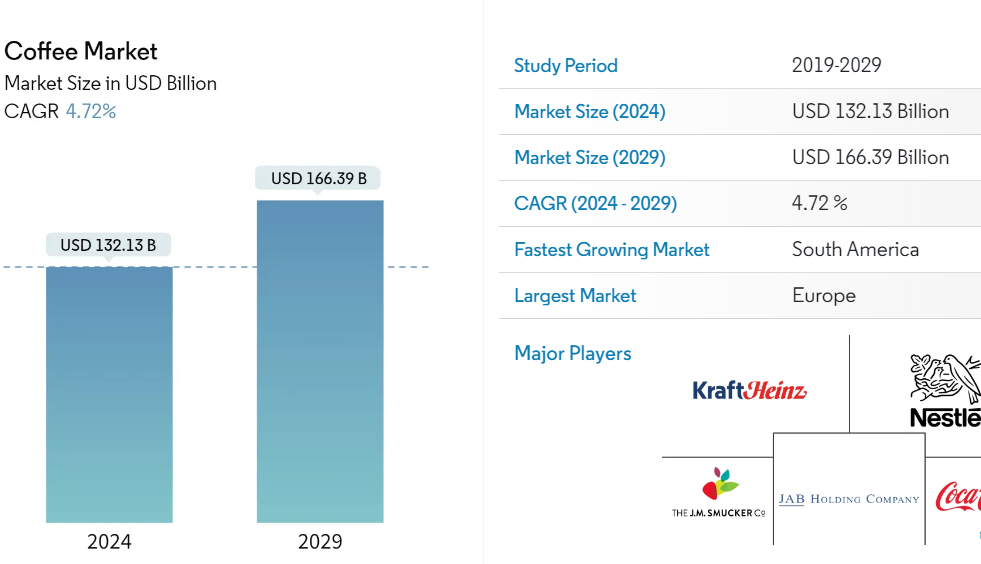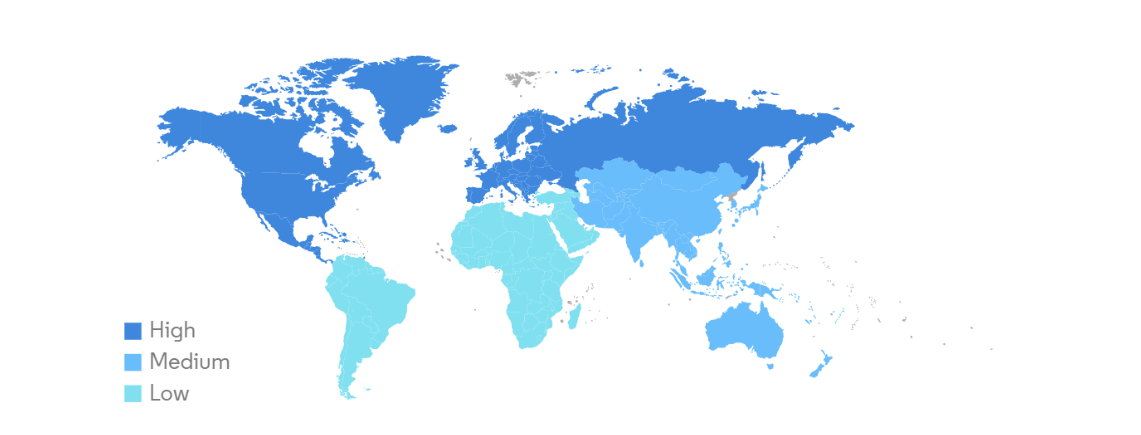
In the bustling landscape of the beverage industry, hot beverages stand out as perennial favorites, offering warmth, comfort, and a delightful sensory experience. As we delve into the world of hot beverages, let’s explore the market dynamics, opportunities, and challenges that shape this vibrant sector.
Understanding the Hot Beverage Market
The hot beverage market encompasses a diverse range of products, including coffee, tea, hot chocolate, and other warm concoctions. According to recent statistics, the global hot beverage market size was valued at approximately USD 194.4 billion in 2020, with a projected hot beverage market growth rate of 5.6% from 2021 to 2028.
Hot Beverage Market Size and Market growth Rate
The global coffee market boasts a sizeable presence, valued at USD 132.13 billion in 2024 and hot beverage market sector projected to reach USD 166.39 billion by 2029, indicating a healthy CAGR of 4.72%.
Hot Beverage Market in India
In India, the hot beverage Industry holds immense potential, fueled by the country’s rich tea-drinking culture and the growing popularity of coffee among urban consumers. The market size for hot beverages in India was estimated to be around USD 1.5 billion in 2020, with a projected growth rate of 8.3% from 2021 to 2026.
Hot Beverage Market Trends
- Rise in Certified Coffee Demand: Consumers increasingly favor certified coffee for its ethical and sustainable attributes, with organic certification gaining traction globally, especially in Asia and Europe. Brands like Blue Tokai are meeting this demand with biodegradable coffee capsules, reflecting a shift towards eco-friendly options.
- Asia Pacific’s Coffee Surge: The Asia-Pacific region, traditionally tea-centric, is witnessing a growing appetite for coffee, fueled by increased consumption in markets like India and China. Coffee chains are expanding in China, capitalizing on the region’s burgeoning coffee culture.
These hot beverage market trends highlight the evolving landscape of the coffee market, driven by consumer preferences for sustainability and the expanding coffee culture in regions like Asia Pacific.
Hot Beverage Market Analysis
- CAGR of 4.72% from 2024 to 2029: Steady growth driven by factors like:
- Busy lifestyles: Convenience and grab-and-go options gain traction.
- Rising disposable income: Increased willingness to spend on premium coffee experiences.
- Health benefits: Perceived positive effects like energy boosts and reduced disease risk.
- Sustainability: Consumers seek ethically and environmentally sourced coffee.
- Technological advancements: Innovation in brewing methods and personalized experiences.
The Coffee Market: Segmentation
The global coffee market boasts a diverse landscape in hot beverages, segmented by product type, distribution channel, and geography, each revealing valuable insights:
Product Type
- Whole-bean: Offers customization and freshness, favored by coffee enthusiasts (market share varies regionally).
- Ground Coffee: Convenient and readily available, dominates off-trade channels (33% market share globally).
- Instant Coffee: Quick and accessible, popular in emerging markets (20.7% market share, expected to grow fastest).
- Coffee Pods and Capsules: Rise of single-serve brewing drives growth (fastest-growing segment, with Keurig Dr Pepper Inc. holding a dominating 53.4% share in the US).
Distribution Channel
- On-trade: Coffee shops and restaurants offer premium experiences and convenience (growing segment due to busy lifestyles).
- Off-trade: Supermarkets, hypermarkets, convenience stores, and specialist retailers offer wider accessibility and variety (off-trade leads, with supermarkets/hypermarkets dominating).
Geography
- North America: Largest market (USD 64.8 billion in 2024), driven by established coffee culture and disposable income.
- Europe: Mature market (USD 38.5 billion in 2024), known for high coffee consumption and diverse preferences.
- Asia-Pacific: Fastest-growing market (USD 20.3 billion in 2024), fueled by rising disposable income and changing lifestyle habits (India and China leading the charge).
- South America: Emerging market (USD 5.9 billion in 2024), with potential for future growth in Brazil and Argentina.
- Middle East & Africa: Smaller market (USD 2.7 billion in 2024), but shows potential for expansion in specific regions like the United Arab Emirates.
Read More- Seizing the Opportunities in the Dynamic Apparel Market
Major Players in the Hot Beverage Market
Major players in the hot beverage market major players include Nestlé, Unilever, Starbucks Corporation, Tata Global Beverages, and The Coca-Cola Company. These industry giants dominate the market landscape through a combination of product innovation, extensive distribution networks, and strategic partnerships. Going beyond their names and market share, here’s a more detailed look at the major players in the coffee market:
JAB Holding Company:
- Strengths: Large portfolio with diverse brands catering to various preferences, global footprint, focus on acquisitions and investments.
- Market Share: Varies by brand, with significant presence through companies like Peet’s Coffee (5% in US specialty coffee) and Caribou Coffee.
- Products: Diverse, ranging from premium whole-bean coffees to single-serve pods and instant options.
- Innovation: Focuses on expanding existing brands and acquiring innovative companies, like the recent acquisition of sustainable coffee brand Stumptown Coffee Roasters.
Nestlé S.A.:
- Strengths: Extensive product range (coffee, tea, chocolate), strong brand recognition, leading positions in multiple segments, robust R&D and innovation programs.
- Market Share: 24.2% in global coffee, 14.7% in global tea.
- Products: Iconic brands like Nescafé, Nespresso, and Nestea. Offers whole-bean, ground, instant, and pod formats.
- Innovation: Focuses on premiumization, convenience, and sustainability. Examples include Nespresso Vertuo pods with larger brewing capacity and eco-friendly packaging initiatives.
Unilever:
- Strengths: Global reach, strong brand portfolio, commitment to sustainability and ethical sourcing.
- Market Share: 15.4% in global tea.
- Products: Primarily focuses on tea brands like Lipton and PG Tips, offering various blends and formats.
- Innovation: Develops innovative tea blends catering to changing consumer preferences, like functional teas with added benefits. Emphasizes sustainable sourcing and packaging.
Starbucks Corporation:
- Strengths: Strong brand recognition, premium coffee experience, loyal customer base, focus on digitalization and mobile app integrations.
- Market Share: 4.1% in global coffee.
- Products: Extensive menu of espresso-based beverages, brewed coffee, seasonal drinks, and food items.
- Innovation: Focuses on menu innovation, personalization options, and expanding its grab-and-go offerings. Emphasizes digital ordering and payment options.
Keurig Dr Pepper Inc.:
- Strengths: Leading position in single-serve coffee market, diverse partnerships with coffee roasters, strong distribution network.
- Market Share: 53.4% in US single-serve coffee.
- Products: Primarily known for Keurig single-serve brewing machines and coffee pods, with partnerships offering various coffee brands and flavors.
- Innovation: Develops new brewing technologies and pod formats, partners with diverse roasters for wider flavor profiles, and explores cold beverage offerings.
Additional Players:
- Kraft Heinz Company: Owns iconic brands like Maxwell House and Gevalia, with a strong presence in ground and instant coffee segments.
- Luigi Lavazza S.p.A.: Italian coffee roasting company with a focus on premium offerings and international expansion.
- Massimo Zanetti Beverage Group: Owns popular brands like Segafredo Zanetti and Illy, with a strong footprint in Europe and growing presence in Asia-Pacific.
Opportunities in the Hot Beverage Industry
The hot beverage industry presents numerous opportunities in hot beverage Industry for growth and innovation. With increasing health consciousness among consumers, there is a rising demand for functional and wellness-oriented hot beverages, such as herbal teas and antioxidant-rich blends. Additionally, the growing trend of premiumization opens doors for luxury hot beverage offerings targeting affluent consumers.
- Emerging Markets: Focus on untapped markets like India, Southeast Asia, and Africa, catering to evolving preferences and local tastes.
- Plant-based and Organic Coffee: Cater to the growing demand for healthier and sustainable coffee options.
- Direct-to-Consumer Models: Build relationships with consumers through personalized subscriptions and online platforms.
- Technology Integration: Leverage technology to optimize farming, production, and distribution, and personalize customer experiences.
- Sustainability Initiatives: Implement ethical sourcing practices, reduce waste, and embrace eco-friendly packaging to attract sustainability-conscious consumers.
Challenges in the Hot Beverage Market
Despite its promising outlook, the challenges in hot beverage market faces several challenges, including fluctuating raw material prices, stringent regulations regarding caffeine content and food safety standards, and intense competition from substitute beverages. Moreover, the COVID-19 pandemic has disrupted supply chains and consumer behavior, posing additional challenges for industry players.
- Climate Change: Threats to coffee bean production due to changing weather patterns and extreme weather events can disrupt supply chains and impact pricing.
- Volatility in Raw Material Prices: Fluctuations in the price of coffee beans can squeeze profit margins for businesses.
- Competition: The market is fiercely competitive, demanding constant innovation and differentiation to attract and retain customers.
- Regulatory Landscape: Changing regulations around trade, sustainability, and labor practices can pose compliance challenges.
Future Outlook of the Hot Beverage Market
Looking ahead, the hot beverage market future outlook is poised for steady growth, driven by factors such as urbanization, changing consumer preferences, and the emergence of new distribution channels. Hot Beverage Market Segmentation of the market into product categories, distribution channels, and regional markets allows for targeted strategies and tailored offerings to meet diverse consumer needs.
- Market Expansion: Projected to reach USD 166.39 billion by 2029, growing at a steady CAGR of 4.72%, driven by rising disposable income, urbanization, and growing coffee culture, particularly in emerging markets like Asia-Pacific.
- Shifting Preferences: Consumers will increasingly seek premiumization, personalization, and convenience, fueling demand for specialty coffee, single-serve formats, and personalized brewing experiences.
- Sustainability Focus: Ethical and environmentally conscious sourcing, recyclable packaging, and carbon-neutral operations will become crucial differentiators.
- Technological Advancements: Artificial intelligence, automation, and data analytics will revolutionize coffee farming, production, and distribution, optimizing efficiency and personalization.
Conclusion
In conclusion, the hot beverage market represents a dynamic and evolving sector within the broader beverage industry. With a rich array of products, robust market growth, and ample opportunities for innovation, this sector holds immense potential for stakeholders. By navigating challenges, embracing opportunities, and staying attuned to consumer preferences, industry players can unlock the full potential of the hot beverage market and satisfy the thirst for warmth and indulgence worldwide.


